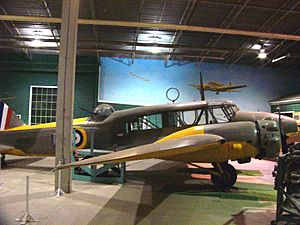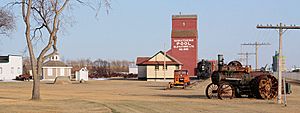Western Development Museum facts for kids
 |
|

Saskatoon branch of the Western Development Museum
|
|
| Established | April 2, 1949 |
|---|---|
| Location | Moose Jaw, North Battleford, Saskatoon and Yorkton. |
| Type | Transportation history, agriculture history, economic history, human history |
The Western Development Museum is a group of four cool museums in Saskatchewan, Canada. These museums help us remember and understand how the province grew and changed over time. Each museum is in a different city: Moose Jaw, North Battleford, Saskatoon, and Yorkton.
Each museum branch focuses on a special theme. For example, one is about transportation, another about agriculture (farming), one about the economy (how people made a living), and another about the people who settled Saskatchewan. The museum works with other big museum groups in Canada.
Contents
History of the Museum
The idea for the Western Development Museum started with people in the community. They wanted to save important parts of Saskatchewan's past. The museum officially began in 1949 when a special law was passed.
The very first museum opened in 1949 in North Battleford. It was in a renovated airplane hangar. Later that same year, a second museum opened in Saskatoon in another old hangar. In 1951, a third museum was set up in Yorkton.
Years later, in the 1970s, new buildings were built just for the museums. New locations opened in Yorkton and Saskatoon in 1972. Then, in 1976, a new museum was added in Moose Jaw.
Moose Jaw: All About Transportation
The Western Development Museum in Moose Jaw is all about how people and things moved around. You can find it at coordinates 50°25′11″N 105°31′50″W / 50.4197°N 105.5305°W.
Planes and Flying Machines
This museum has a special focus on airplanes and flying. This makes sense because it's close to CFB Moose Jaw, a big air force base. You can see a special display about the Snowbirds. They are Canada's famous aerobatic flying team.
The museum's collection of aircraft includes many interesting planes. You can see an American Aerolights Eagle ultralight plane. There is also an Avro Anson bomber trainer, which was used to teach pilots. Other planes include a Canadair CT-114 Tutor (like the Snowbirds fly) and a Canadair CT-133 Silver Star.
Trains and Railways
The Moose Jaw museum also has a cool outdoor train ride. It's called the Western Development Museum Short Line. This train uses a special narrow track. It has the only working steam locomotive in all of Saskatchewan!
North Battleford: Pioneer Farm & Village
The museum in North Battleford shows what life was like for pioneers. It focuses on both farm life and village life from the past. You can find it at coordinates 52°45′14″N 108°15′30″W / 52.7538°N 108.2584°W.
Farm Life Exhibits
Inside a large barn, you can see different farm animals. The museum also shows how farmers worked their land in the 1920s. You can learn about the tools and methods they used.
Pioneer Village Exploration
The North Battleford museum has a whole pioneer village! It's like stepping back in time. You can see a tall grain elevator, a co-operative store, and several old churches. There are also businesses and homes from the pioneer era. A real grain elevator from Keatley, Saskatchewan was moved to the museum in 1983.
Saskatoon: 1910 Boomtown
The Saskatoon branch of the Western Development Museum is famous for its indoor "boomtown." This town shows what a busy Saskatchewan town looked like around 1910. You can find it at coordinates 52°05′42″N 106°40′24″W / 52.0950°N 106.6733°W.
Exploring the Boomtown
The museum has real buildings from that time period. They are kept indoors in a special climate-controlled area. These buildings are filled with old items from the 1910s. You can explore a homestead (a pioneer home), a police station, and a bank. There's also a newspaper office with a working printing press!
Other interesting places in the boomtown include a saddle shop, a general store, and even a dentist's office. The museum also displays old automobiles and farm equipment. The Saskatoon branch also has meeting rooms and is home to the Saskatchewan Agricultural Hall of Fame.
Recent Updates and Partnerships
In 2005, the Saskatoon museum got a big makeover. This was to celebrate Saskatchewan's 100th birthday as a province.
In 2022, the museum started an exciting partnership. They worked with the Whitecap Dakota First Nation to create a new exhibit. It's called "Wapaha Sk̄a Oyate: Living Our Culture, Sharing Our Community at Pion-Era, 1955 – 69." This exhibit shows the friendship between the museum and the First Nation. It tells how Indigenous peoples shared their stories at an event called Pion-Era many years ago.
The exhibit includes Dakota artifacts, a horse and travois (a type of sled), and many photographs. It also shares historical stories and oral histories from the community. This special exhibit officially opened in October 2022.
Yorkton: The Story of People
The Yorkton branch of the museum tells the story of the people who came to live in western Canada. It focuses on the experiences of immigrants. You can find it at coordinates 51°13′04″N 102°29′03″W / 51.2177°N 102.4841°W.
Immigrant Experiences
This museum shows scenes that highlight the cultures of many groups who settled in Saskatchewan. You can learn about Ukrainians, English, Swedes, Germans, Doukhobors, and Icelanders.
Saskatchewan's History and More
One exhibit shows 100 years of Saskatchewan's history. It has a timeline from 1905 to 2005. There are also displays from the mid-1800s, before Saskatchewan became a province. This exhibit includes presentations in the Saskatchewan Theatre. You can also see a log home that was moved to the museum in 2002.
Other exhibits include special showcase rooms and a railway station mural. There's also an exhibit about Yorkton's local history. A fun area called "Time Square" is designed just for children. You can also see a collection of toys from the early 1900s in an exhibit called "In a Prairie Attic: Bladon Family Toys."
Cool Things to See
The Western Development Museum has some very special items.
- The museum has the last remaining Ferranti-Packard 6000. This was an early type of large computer designed in Canada.
- Volunteers are building a copy of the Canadian Vickers Vedette airplane. This was a Canadian-designed plane. The museum has part of an original hull on display.
Images for kids
See also
 In Spanish: Western Development Museum para niños
In Spanish: Western Development Museum para niños







